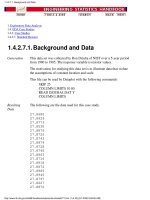Engineering Statistics Handbook Episode 2 Part 1 docx
Bạn đang xem bản rút gọn của tài liệu. Xem và tải ngay bản đầy đủ của tài liệu tại đây (135.93 KB, 22 trang )
Discrete
Distributions
Binomial
Distribution
Poisson Distribution
1.3.6.6. Gallery of Distributions
(3 of 3) [5/1/2006 9:57:54 AM]
1. Exploratory Data Analysis
1.3. EDA Techniques
1.3.6. Probability Distributions
1.3.6.6. Gallery of Distributions
1.3.6.6.1.Normal Distribution
Probability
Density
Function
The general formula for the probability density function of the normal
distribution is
where is the location parameter and is the scale parameter. The case
where
= 0 and = 1 is called the standard normal distribution. The
equation for the standard normal distribution is
Since the general form of probability functions can be expressed in
terms of the standard distribution, all subsequent formulas in this section
are given for the standard form of the function.
The following is the plot of the standard normal probability density
function.
1.3.6.6.1. Normal Distribution
(1 of 7) [5/1/2006 9:57:55 AM]
Cumulative
Distribution
Function
The formula for the cumulative distribution function of the normal
distribution does not exist in a simple closed formula. It is computed
numerically.
The following is the plot of the normal cumulative distribution function.
1.3.6.6.1. Normal Distribution
(2 of 7) [5/1/2006 9:57:55 AM]
Percent
Point
Function
The formula for the percent point function of the normal distribution
does not exist in a simple closed formula. It is computed numerically.
The following is the plot of the normal percent point function.
Hazard
Function
The formula for the hazard function of the normal distribution is
where is the cumulative distribution function of the standard normal
distribution and
is the probability density function of the standard
normal distribution.
The following is the plot of the normal hazard function.
1.3.6.6.1. Normal Distribution
(3 of 7) [5/1/2006 9:57:55 AM]
Cumulative
Hazard
Function
The normal cumulative hazard function can be computed from the
normal cumulative distribution function.
The following is the plot of the normal cumulative hazard function.
1.3.6.6.1. Normal Distribution
(4 of 7) [5/1/2006 9:57:55 AM]
Survival
Function
The normal survival function can be computed from the normal
cumulative distribution function.
The following is the plot of the normal survival function.
Inverse
Survival
Function
The normal inverse survival function can be computed from the normal
percent point function.
The following is the plot of the normal inverse survival function.
1.3.6.6.1. Normal Distribution
(5 of 7) [5/1/2006 9:57:55 AM]
Common
Statistics
Mean
The location parameter
.
Median
The location parameter .
Mode
The location parameter .
Range Infinity in both directions.
Standard Deviation The scale parameter
.
Coefficient of
Variation
Skewness 0
Kurtosis 3
Parameter
Estimation
The location and scale parameters of the normal distribution can be
estimated with the sample mean and sample standard deviation,
respectively.
Comments For both theoretical and practical reasons, the normal distribution is
probably the most important distribution in statistics. For example,
Many classical statistical tests are based on the assumption that
the data follow a normal distribution. This assumption should be
tested before applying these tests.
●
In modeling applications, such as linear and non-linear regression,
the error term is often assumed to follow a normal distribution
with fixed location and scale.
●
The normal distribution is used to find significance levels in many
hypothesis tests and confidence intervals.
●
1.3.6.6.1. Normal Distribution
(6 of 7) [5/1/2006 9:57:55 AM]
Theroretical
Justification
- Central
Limit
Theorem
The normal distribution is widely used. Part of the appeal is that it is
well behaved and mathematically tractable. However, the central limit
theorem provides a theoretical basis for why it has wide applicability.
The central limit theorem basically states that as the sample size (N)
becomes large, the following occur:
The sampling distribution of the mean becomes approximately
normal regardless of the distribution of the original variable.
1.
The sampling distribution of the mean is centered at the
population mean,
, of the original variable. In addition, the
standard deviation of the sampling distribution of the mean
approaches
.
2.
Software
Most general purpose statistical software programs, including Dataplot,
support at least some of the probability functions for the normal
distribution.
1.3.6.6.1. Normal Distribution
(7 of 7) [5/1/2006 9:57:55 AM]
Cumulative
Distribution
Function
The formula for the cumulative distribution function of the uniform
distribution is
The following is the plot of the uniform cumulative distribution function.
1.3.6.6.2. Uniform Distribution
(2 of 7) [5/1/2006 9:57:56 AM]
Percent
Point
Function
The formula for the percent point function of the uniform distribution is
The following is the plot of the uniform percent point function.
Hazard
Function
The formula for the hazard function of the uniform distribution is
The following is the plot of the uniform hazard function.
1.3.6.6.2. Uniform Distribution
(3 of 7) [5/1/2006 9:57:56 AM]
Cumulative
Hazard
Function
The formula for the cumulative hazard function of the uniform distribution is
The following is the plot of the uniform cumulative hazard function.
1.3.6.6.2. Uniform Distribution
(4 of 7) [5/1/2006 9:57:56 AM]
Survival
Function
The uniform survival function can be computed from the uniform cumulative
distribution function.
The following is the plot of the uniform survival function.
Inverse
Survival
Function
The uniform inverse survival function can be computed from the uniform
percent point function.
The following is the plot of the uniform inverse survival function.
1.3.6.6.2. Uniform Distribution
(5 of 7) [5/1/2006 9:57:56 AM]
Common
Statistics
Mean (A + B)/2
Median (A + B)/2
Range B - A
Standard Deviation
Coefficient of
Variation
Skewness 0
Kurtosis 9/5
Parameter
Estimation
The method of moments estimators for A and B are
The maximum likelihood estimators for A and B are
1.3.6.6.2. Uniform Distribution
(6 of 7) [5/1/2006 9:57:56 AM]
Comments The uniform distribution defines equal probability over a given range for a
continuous distribution. For this reason, it is important as a reference
distribution.
One of the most important applications of the uniform distribution is in the
generation of random numbers. That is, almost all random number generators
generate random numbers on the (0,1) interval. For other distributions, some
transformation is applied to the uniform random numbers.
Software
Most general purpose statistical software programs, including Dataplot,
support at least some of the probability functions for the uniform distribution.
1.3.6.6.2. Uniform Distribution
(7 of 7) [5/1/2006 9:57:56 AM]
Cumulative
Distribution
Function
The formula for the cumulative distribution function for the Cauchy
distribution is
The following is the plot of the Cauchy cumulative distribution function.
1.3.6.6.3. Cauchy Distribution
(2 of 7) [5/1/2006 9:57:57 AM]
Percent
Point
Function
The formula for the percent point function of the Cauchy distribution is
The following is the plot of the Cauchy percent point function.
Hazard
Function
The Cauchy hazard function can be computed from the Cauchy
probability density and cumulative distribution functions.
The following is the plot of the Cauchy hazard function.
1.3.6.6.3. Cauchy Distribution
(3 of 7) [5/1/2006 9:57:57 AM]
Cumulative
Hazard
Function
The Cauchy cumulative hazard function can be computed from the
Cauchy cumulative distribution function.
The following is the plot of the Cauchy cumulative hazard function.
1.3.6.6.3. Cauchy Distribution
(4 of 7) [5/1/2006 9:57:57 AM]
Survival
Function
The Cauchy survival function can be computed from the Cauchy
cumulative distribution function.
The following is the plot of the Cauchy survival function.
Inverse
Survival
Function
The Cauchy inverse survival function can be computed from the Cauchy
percent point function.
The following is the plot of the Cauchy inverse survival function.
1.3.6.6.3. Cauchy Distribution
(5 of 7) [5/1/2006 9:57:57 AM]
Common
Statistics
Mean The mean is undefined.
Median The location parameter t.
Mode The location parameter t.
Range Infinity in both directions.
Standard Deviation The standard deviation is undefined.
Coefficient of
Variation
The coefficient of variation is undefined.
Skewness The skewness is undefined.
Kurtosis The kurtosis is undefined.
Parameter
Estimation
The likelihood functions for the Cauchy maximum likelihood estimates
are given in chapter 16 of Johnson, Kotz, and Balakrishnan. These
equations typically must be solved numerically on a computer.
1.3.6.6.3. Cauchy Distribution
(6 of 7) [5/1/2006 9:57:57 AM]
Comments The Cauchy distribution is important as an example of a pathological
case. Cauchy distributions look similar to a normal distribution.
However, they have much heavier tails. When studying hypothesis tests
that assume normality, seeing how the tests perform on data from a
Cauchy distribution is a good indicator of how sensitive the tests are to
heavy-tail departures from normality. Likewise, it is a good check for
robust techniques that are designed to work well under a wide variety of
distributional assumptions.
The mean and standard deviation of the Cauchy distribution are
undefined. The practical meaning of this is that collecting 1,000 data
points gives no more accurate an estimate of the mean and standard
deviation than does a single point.
Software
Many general purpose statistical software programs, including Dataplot,
support at least some of the probability functions for the Cauchy
distribution.
1.3.6.6.3. Cauchy Distribution
(7 of 7) [5/1/2006 9:57:57 AM]
These plots all have a similar shape. The difference is in the heaviness
of the tails. In fact, the t distribution with
equal to 1 is a Cauchy
distribution. The t distribution approaches a normal distribution as
becomes large. The approximation is quite good for values of > 30.
Cumulative
Distribution
Function
The formula for the cumulative distribution function of the t distribution
is complicated and is not included here. It is given in the Evans,
Hastings, and Peacock book.
The following are the plots of the t cumulative distribution function with
the same values of
as the pdf plots above.
1.3.6.6.4. t Distribution
(2 of 4) [5/1/2006 9:57:57 AM]
Percent
Point
Function
The formula for the percent point function of the t distribution does not
exist in a simple closed form. It is computed numerically.
The following are the plots of the t percent point function with the same
values of
as the pdf plots above.
1.3.6.6.4. t Distribution
(3 of 4) [5/1/2006 9:57:57 AM]









